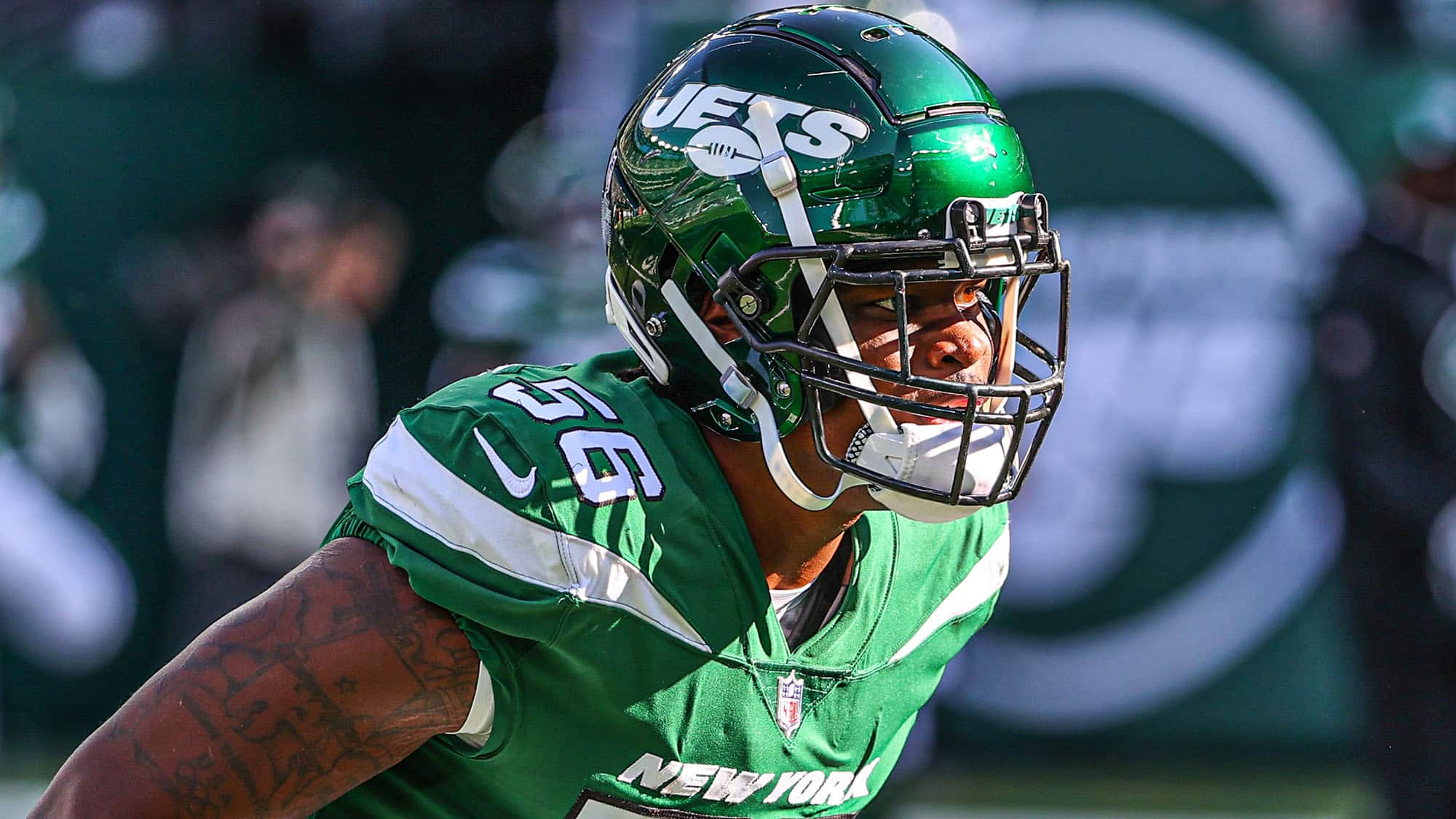New York Jets’ defensive coaching staff shows minor progress
Ranked 32nd in scoring defense with 32.0 points allowed per game, the New York Jets‘ defense has absorbed an enormous amount of criticism this season.
While expectations for the unit are low considering how many injuries it has sustained, frustration has brewed amongst Jets fans regarding the defensive coaching staff’s refusal to make substantial adjustments. Head coach Robert Saleh and defensive coordinator Jeff Ulbrich are under fire.
New York’s defense is getting beaten by the same concepts and game plans every week and little has changed in regards to play-calling tendencies, snap distribution, schematic philosophies, or other aspects of the unit that the coaching staff has control over.
In Week 11, the Jets took a disappointing 24-17 home loss to the 3-7 Miami Dolphins in which the defense allowed Miami to post 388 yards of offense, the Dolphins’ third-best total of the season. It was a step forward for New York after allowing over 30 points in each of the previous four games and at least 45 points in three of the past four, but considering the opponent, it was still a subpar outing.
Nevertheless, the coaching staff began to show some promising signs of adaptability through two particular changes.
Allowing Bryce Hall to travel
When the Jets allowed 45 points to the Buffalo Bills in their Week 10 defeat, a hot topic amongst fans and media was the Jets’ refusal to allow their best cornerback, Bryce Hall, to shadow Buffalo’s top receiver, Stefon Diggs.
The Jets’ defense employs a strict left-side/right-side approach at the cornerback position. Their two starting outside cornerbacks stay on the same side of the field for the entire game. Hall is their left-side cornerback while Brandin Echols was their right-side cornerback before going down with an injury against Buffalo.
Offensive coordinator Brian Daboll exploited this approach by isolating Diggs against the Jets’ right-side cornerbacks – first Echols followed by Javelin Guidry once Echols left the game.
Diggs dominated his one-on-one matchups against the Jets’ lesser cornerbacks while Hall spent most of the game helplessly watching from the other side of the field. Buffalo’s top weapon finished with eight catches on 13 targets for a season-high 162 yards.
Against the coverage of Hall, Diggs caught 2-of-3 targets for 13 yards (4.3 per target), and against the coverage of any other Jet, he caught 6-of-10 targets for 149 yards (14.9 per target).
New York did not adjust, sticking to its bread-and-butter despite the devastating results.
Saleh defended the Jets’ decision after the game, claiming that matching is not something the Jets do and that it would be too reactionary to change things up.
“That’s just not what we do, or how our defense works … We’re not a team that matches up like that. Diggs lines up in certain spots, and to start chasing when that’s not your style … there’s a lot that comes into play when you try to travel and figure out where to go from an alignment standpoint,” Saleh said.
“It sounds simple but we’re not a man-coverage team; it’s not something we do, and we were in those situations trying to get safeties over top of him, but when we did, they went to the other side.”
Sure enough, Saleh and the Jets started to play that kind of football the very next week.
Hall played zero snaps on the right side of the field prior to Week 11. Every one of his 608 defensive snaps from Weeks 1-10 came from the left side.
But against Miami, the Jets finally allowed Hall to move around a little bit. He played 18 of his 71 defensive snaps (25.3%) on the right side of the field.
Hall often shadowed tight end Mike Gesicki, who is a pseudo wide receiver as he rarely lines up in-line. However, there were other situations where Hall simply moved to the right side in an off-zone coverage even without following Gesicki.
The approach was fruitful for Hall. He dropped into coverage on 40 snaps and allowed only 21 yards on five targets, yielding zero first downs and zero touchdowns while committing zero penalties and missing zero tackles.
Highlights from a flawless coverage performance by Bryce Hall vs. Miami
– 40 coverage snaps
– 0 first downs allowed
– 0 missed tackles
– 0 TD allowed
– 0 penalties#Jets pic.twitter.com/uoPgWHzNXl— Michael Nania (@Michael_Nania) November 23, 2021
The Jets do not need Hall to move away from the left side in every game – utilizing a strict left-side/right-side cornerback approach as the base philosophy is perfectly fine and can work excellently – but it is promising that the Jets finally showed a willingness to make slight alterations to best prepare themselves for the particular opponent in front of them.
Benching Jarrad Davis for Quincy Williams
Jarrad Davis signed a one-year, $5.5 million contract this offseason to be the Jets’ second every-down linebacker beside C.J. Mosley. Those plans were put on hold when an ankle injury held Davis out for the first six games.
The Jets dealt with anemic linebacker play beside Mosley while Davis was out, so his return was much anticipated.
Upon returning, Davis looked no better than the players who took his place. He took brutal angles against the run, missed a bevy of tackles, and was a sieve in coverage.
Davis’ 36.4% missed tackle rate is the worst among the 106 linebackers who have played at least 100 defensive snaps this season. He has also allowed a 132.4 passer rating on throws into his coverage, which ranks sixth-worst.
Quincy Williams was one of the players who filled in for Davis during his absence. While Williams made a boatload of mistakes due to over-pursuit and a lack of control, he also balanced out those blunders with a bunch of tremendous plays.
Williams has seven tackles for loss in five games this season where he played a featured role (over 80% of the snaps). That’s an average of 1.4 per game, which would put him on pace for 22.4 tackles for loss per 16 games. For reference, the NFL record for TFLs in one season by an off-ball linebacker is 23 (Kendrell Bell, 2001).
Davis was making the same mistakes as Williams without producing any eye-popping plays to balance it out. He only had two total stops (tackles that constitute a poor result for the offense) in his first three games (0.7 per game). Williams has 19 total stops in his five extended appearances (3.8 per game).
In Week 11, the Jets benched Davis in favor of Williams, handing Williams 63 snaps (88% of plays) while giving Davis only nine snaps (12%).
This switch made sense. Regardless of the investment that was made in each player, Williams has simply been the superior linebacker. Davis was performing at a level that was crushing the entire defense. Williams makes plenty of mistakes himself, but he at least does some good things for you, whereas Davis was providing nothing.
The move is smart from a long-term perspective as well. Williams is under contract for the 2022 season while Davis is not. There is more for the team to gain from Williams producing than Davis.
Plus, Davis is 27 years old and has 59 games (48 starts) of NFL tape that showcase the same recurrent flaws. On the other hand, Williams is 25 years old and only has 27 games (14 starts) on tape. Williams has a much greater chance of improving.
Give the Jets credit for being honest about Davis and quickly making the switch to the better and younger player who is signed for 2022.
Between the alteration of Hall’s usage and the promotion of Williams, the Jets made two of their biggest defensive adjustments of the season in the Miami game. It’s noticeable progress for a defensive staff that must do a better job of maximizing the talent at its disposal.
Next Article: Poorly executed red zone play vs. MIA exemplifies core issues of the Jets defense (Film breakdown)
Audio Version available to members only: Learn more here
Want More NY Jets News & Jets X-Factor Content?
Download the free Jet X Mobile App to get customizable notifications directly to your iOS (App Store) or Google/Android (Google Play) device.
Add Jets X-Factor to your Google News feed to stay up to date with the New York Jets.
Follow us on Twitter @jetsxfactor for all the latest New York Jets news, Facebook for even more, Instagram for some of the top NY Jets images, and YouTube for original Jets X-Factor videos.
Join the official Jets Discord community to connect with likeminded fans.














